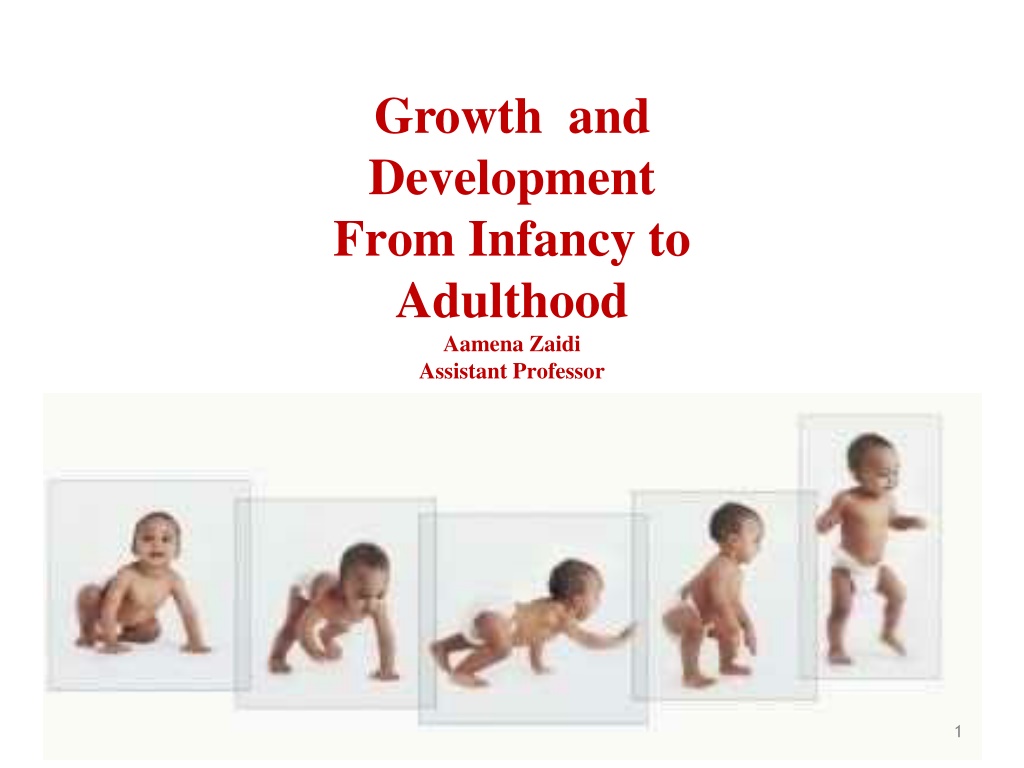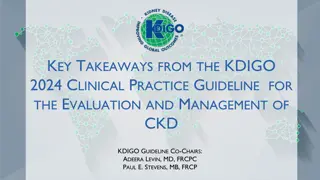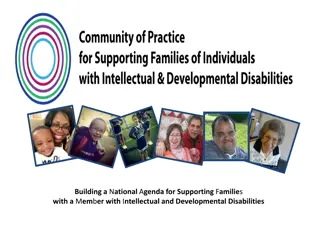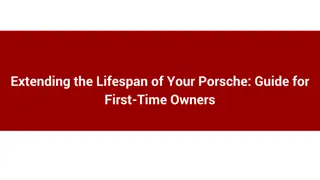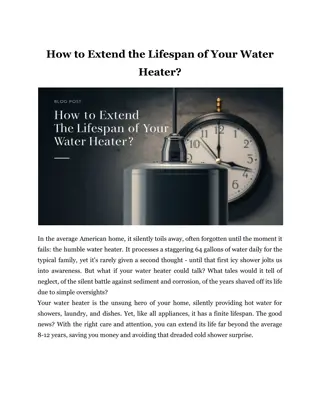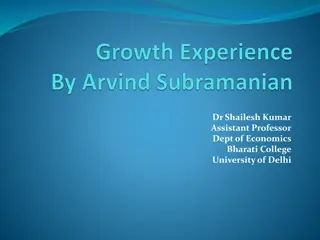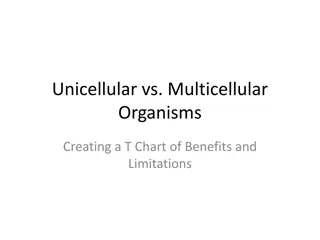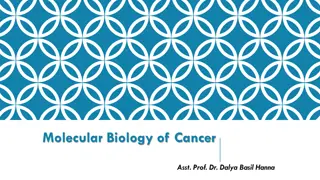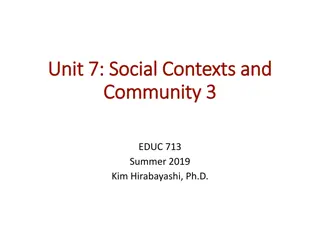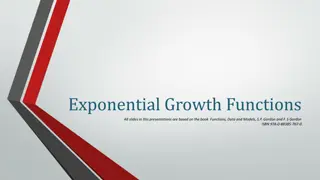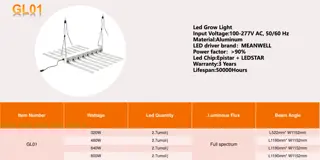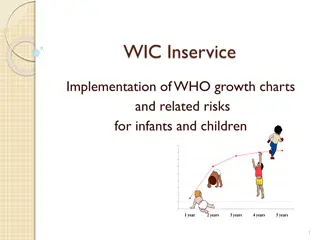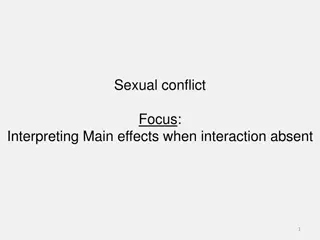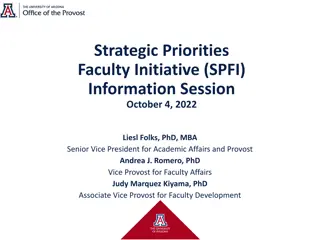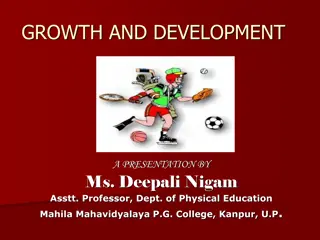Growth and Development Across the Lifespan
Growth and development from infancy to adulthood encompass physical maturation and functional progression. Growth involves the increase in body and organ size through cell multiplication, while development entails the enhancement of skills and capacities, including psychological and social changes. Principles such as the cephalocaudal and proximodistal directions guide the progression from general to specific responses. This continuous process unfolds from birth through childhood into adulthood.
Download Presentation

Please find below an Image/Link to download the presentation.
The content on the website is provided AS IS for your information and personal use only. It may not be sold, licensed, or shared on other websites without obtaining consent from the author.If you encounter any issues during the download, it is possible that the publisher has removed the file from their server.
You are allowed to download the files provided on this website for personal or commercial use, subject to the condition that they are used lawfully. All files are the property of their respective owners.
The content on the website is provided AS IS for your information and personal use only. It may not be sold, licensed, or shared on other websites without obtaining consent from the author.
E N D
Presentation Transcript
Growth and Development From Infancy to Adulthood Aamena Zaidi Assistant Professor 1
Growth It is the process of physical maturation resulting an increase in size of the body and various organs. It occurs by multiplication of cells and an increase in intracellular substance. It is quantitative changes of the body. 2
Development It is the process of functional and physiological maturation of the individual. It is progressive increase in skill and capacity to function. It is related to maturation and myelination of the nervous system. It includes psychological, emotional and social changes. It is qualitative in aspect. 3
Principle of Growth and Development 4
Cephalocaudal direction Proximodistal direction General to Specific 5
Cephalocaudal direction The process of cephalocaudal direction from head down to tail. This means that improvement in structure and function come first in the head region, then in the trunk, and last in the leg region. 6
Proximodistal direction The process in proximodistal from center or midline to periphery direction. development proceeds from near to far - outward from central axis of the body toward the extremities 7
General to Specific Children use their cognitive and language skills to reason and solve problems. Children at first are able hold the big things by using both arms, In the next part able to hold things in a single hand, then only able to pick small objects like peas, cereals etc. Children when able to hold pencil, first starts draw circles then squares then only letters after that the words. 8
Development proceeds from generalto specificresponses
From Birth to Adulthood 1-For the first year after birth, a baby is called an infant. Childhood begins at age two and continues until adolescence. Adolescence is the last stage of life before adulthood. A-Infancy Infancy is the first year of life after birth. Infants are born with a surprising range of abilities. They have well- developed senses of touch, hearing, and smell. They can also communicate their needs by crying
Infancy By 6 weeks after birth, infants typically start smiling making vocal sounds. By 6 months, infants are babbling. They have also learned to sit and are starting to crawl. The deciduous teeth (baby teeth) have started to come in. By 12 months, infants may be saying their first words. They usually can stand with help and may even have started to walk. Infancy is the period of most rapid growth after birth. Growth is even faster during infancy that it is during puberty. By the end of the first year, the average baby is twice as long as it was at birth and three times as heavy.
Childhood A toddler is a child aged 1 to 3 years. Children of this age are learning to walk, or toddle. Growth is still relatively rapid during the toddler years but it has begun to slow down. 1-By age 4, most children can run, climb stairs. They know many words and use simple sentences. The majority are also toilet trained. 2-By age five, children are able to carry on conversations, recognize letters and words, and use a pencil to trace letters. They can usually tie their own shoelaces and may be learning to ride a bicycle, swing a bat, kick a ball and play other games
3-By age 6, most children begin losing their deciduous teeth, and their perm permanent teeth start coming in. They speak fluently and are learning to read and write. They spend more time with peers and develop friendships. Older children continue to grow slowly until they start the adolescent growth spurt during puberty. They also continue to develop mentally, emotionally, and socially
Puberty Puberty is the stage of life when a child becomes sexually mature. Puberty begins when the pituitary gland tells the testis to secrete testosterone in boys, and in girls the pituitary gland signals the ovaries to secrete estrogen. Adolescence Adolescence is the period of transition between the beginning of puberty and adulthood. Adolescence is also a time of significant mental, emotional, and social changes. For example: *Adolescents generally develop the ability to think abstractly. *Adolescents may have mood swings because of surging hormones. *Adolescents usually try to be more independent from their parents. *Adolescents typically spend much of their time with peers. *Adolescents may start to develop intimate relationships.
Factorinfluencing Growth andDevelopment 15
Growth and development depend upon multiple factors or determinates. They influence directly or indirectly by promoting or hindering the process. 16
Genetic factors Prenatal factors Postnatal factors 17
Genetic factors Genetic predisposition is an important factor which influence the growth and development of children. Sex Race and Nationality 18
Prenatal factors Intrauterine environment is an important predominant factor of growth and development. Various conditions influence the foetal growth in uterus. 19
Cont Maternal malnutrition Maternal infection Maternal drug/alcohol abuse Maternal illness Hormones 20
Postnatal factors Growth potential Nutrition Childhood illness Physical environment Psychological environment Cultural influence Socio economic status Climate and season Play and exercise Birth order of the child Intelligence Hormonal influence 21
GROWTH AND&DEVELOPMENTAL AGE PERIODS Infancy Neonate Birth to 1 month Infancy 1 month to 1 year
Early Childhood Toddler 1-3 years Preschool 3-6 years 18
Middle Childhood School age 6 to 12 years Late Childhood Adolescent 13 years to approximately 18 years
The Importance of Nutrition in Early Childhood Development The relationship between nutrition, health and learning is undeniably strong: nutrition is one of the three major factors that impact a child s development. As genes and environment are the other two factors, research studies show that nutrition in a child s early years is linked to their health and academic performance in later year Malnutrition lead to poor brain development that result in irreversible chronic illnesses. Under-nutrition of a breastfeeding mother will likewise negatively impact a child s development, especially in the first 6 months when breast milk is all he/she is consuming. For all soon-to- be and new mothers, it s worth making sure you re consuming a healthy and balanced diet full of the vital nutrients that both you and your child need: carbohydrates, protein, calcium, iron and vitamins A, C and D.
The benefits of good nutrition to health are endless, but the following few conclusions made by researchers serve to prove my point. 1-Firstly, breastfeeding by mothers following nutritious diets leads to fewer and less severe cases among their children of illnesses including diarrhoea, ear infection and bacterial meningitis. This is because better-nourished children have an enhanced natural ability to fight infection. 2-Secondly, since iron is a vital component of brain tissue, iron deficiency makes nerve impulses move slower and may cause permanent damage to a child s brain, especially in the first two years of his/her life; iron deficiency during this time is linked to behaviour changes and delayed psychomotor development. 3-Thirdly, under-nutrition has been proven to decrease a child s activity levels, social interactions, curiosity and cognitive functioning.
The Impact of Nutrition on our Health Unhealthy eating habits have contributed to the obesity. About adults (33.8%) are obese and approximately 17% (or 12.5 million) of children and adolescents aged 2 19 years are obese.1 Even for people at a healthy weight, a poor diet is associated with major health risks that can cause illness and even death. These include heart disease, hypertension, type 2 diabetes, osteoporosis, and certain types of cancer. The risk factors for adult chronic diseases, like hypertension and type 2 diabetes, are increasingly seen in younger ages, often a result of unhealthy eating habits and increased weight gain. Dietary habits established in childhood often carry into adulthood, so teaching children how to eat healthy at a young age will help them stay healthy throughout their life. The link between good nutrition and healthy weight, reduced chronic disease risk, and overall health is too important to ignore. By taking steps to eat healthy, getting the nutrients our body needs to stay healthy, active, and strong. As with physical activity, making small changes in our diet can go a long way.
Assessment ofDevelopment Normal development is a complex process & has a multitude of facets. However, it is convenient to understand & assess development under the following domains. 29
Cont Gross motor development Fine motor skill development Personal & social development Language Vision & hearing. 30
Gross motor development Motor development progress in an orderly sequence to ultimate attainment of locomotion & more complex motor tasks thereafter. In an infant it is assessed & observed as follows:- 31
Key gross motor developmentmilestones Cont Age Milestone 3months Neck holding 5months Rolls over 6months Sits with own support 8months Sitting without support 9months Standing holding on (with support) 12months Creep well, stand without support 15months Walks alone creeps upstairs 18months Runs 2 yr Walks up and down stairs 3 yr Rides tricycle, 4yr Hops on one foot, alternate feet going downstairs. 52
Fine motor skill development Fine motor development upon neural tract maturation. Fine motor development promotes adaptive actives with fine sensory-motor adjustments and include eye coordination, hand eye coordination, hand to mouth coordination, hand skill as finger thumb position,grasping, dressing etc. 53
Key fine motor development milestone Age Milestone 4 months reaching out for the objects with both hands 6months Reaching out for the objects with one hand 9months Immature pincer graps 12months Pincer graps mature 15months Imitates scribbling, tower of 2 blocks 18months Scribbles, tower of 3 blocks 2 years Tower of 6 blocks, vertical and circular stroke 3 years Tower of 9 blocks, copies circle 4years Copies cross, bridge with blocks 5years Copies triangle, gate with blocks 54
Personal & social development Personal and social development includes personal reactions to his own social and cultural situations with neuromotor maturity and environment stimulation. It is related to interpersonal and social skill as social smile, recognition of mother, use of toys. 35
Key social and adaptive milestones Age Milestone 2months Social smile 3months Recognizes mother 6months Recognizes strangers, stranger anxiety 9months Waves bye bye 1 year Comes when called, plays simple ball game 1 year and 3 months 1.5 years Jargon Copies parents in tasks 2yr Asks for food, drink, toilet 3yr Shares toys, knows full name andgender 4yr Plays cooperatively in a group, goes to toilet alone. 5yr Helps in household tasks, dressing andundressing 36
Language development Age 1m 3m 4m 6m 9m 12m 18 m 2yr Milestone Alerts to sound Coos ( musical vowel sounds) Laugh loud Monosyllables (ba, da, pa) sound Bisyllables ( mama, baba, dada) sound 1-2 words with meaning 8 -10 words vocabulary 2-3 word sentences, uses pronouns I , Me , you 3 yr 4yr 5yr Ask question Says songs or poem, tell stories Asks meaning of words 57
